Leadership Development Comprehensive Guide
This leadership development blog is a comprehensive guide. The leadership guide was developed based on SQM Group's over 25 years of helping call center leaders (e.g., supervisor to SVP) measure, benchmark, and improve customer satisfaction and agent engagement. This leadership development guide will answer the following five customer satisfaction questions.
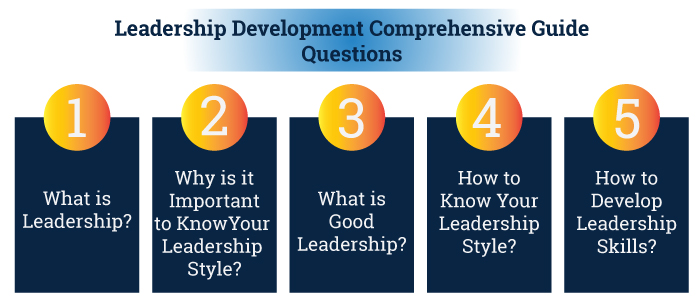
1. What is the Leadership Definition?
Leadership is a complex topic that has been discussed and debated by practitioners, researchers, and academics for a long time. However, there is a general acceptance that leadership styles can be defined as a behavioral approach that a leader uses to influence the behavior of their followers (e.g., providing direction, managing, and motivating employees).
So, what do you think is your leadership style by completing this sentence: "A good leader should always..." How you complete this sentence might describe your leadership style.
Many leaders believe a leadership style that works for one call center, line of business, team, or situation may not work for another. In other words, the right leadership style for a call center or team depends on the needs, personalities of direct reports, and the business situation. However, good leadership is not only about senior managers or the vice president of a call center. In fact, effective leaders can be found at all levels (e.g., supervisors to SVP) and use different leadership styles or elements of each unique leadership style.
2. Why Is It Important to Know Your Leadership Style?
Most call center practitioners believe a supervisor's leadership style is essential for helping agents achieve high performance. Therefore, knowing your leadership style is important for a call center leader to help deliver great customer satisfaction and agent engagement. A recent poll we conducted showed that leadership style is the second most important call center supervisor skill, just behind their coaching ability. Additionally, it is widely believed that the supervisor's leadership and coaching ability are the keys to helping agents improve First Call Resolution (FCR) and Customer Satisfaction (Csat).
There are many different leadership styles. Therefore, most managers need to know their style to learn, develop and improve on how to be effective leaders. Furthermore, if you need to improve your leadership skills or want to advance in your career, you need to know your style and be willing to put in the effort to enhance your leadership style.
Knowing your leadership style (e.g., taking a questionnaire to find your style) helps a leader to enhance their managerial skills. For example, is your leadership style approach servant, transformational, participative, transactional, autocratic, or laissez-faire style? Furthermore, by knowing your leadership style, you are better equipped to discover how to improve your leadership skills by understanding where your leadership falls in these styles.
3. What Is a Good Leadership Style?
Good leadership is not only about senior managers working at a call center. In fact, good leaders can be found at all levels (e.g., supervisors to SVP), and they can use different leadership styles. While there are many leadership styles used in call centers, it has been SQM's experience that servant, participative and transformational have been the most effective for achieving high customer satisfaction and agent engagement.
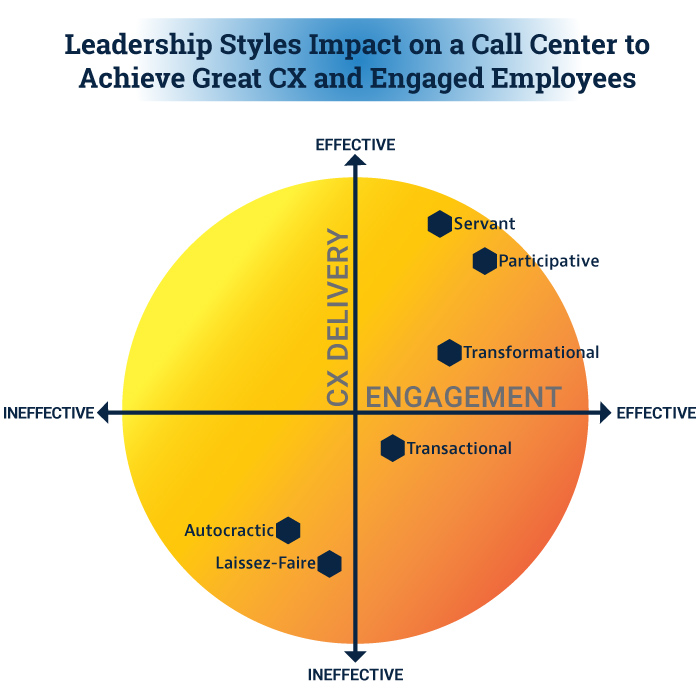
Many managers' leadership style is rooted in their personalities, experience, and preference. However, strictly adhering to only one leadership style can hinder a call center leader's or company's success in achieving high call center Csat and agent engagement.
A widely recognized approach to leadership is to use a situational leadership style. This leadership approach is based on the demands of a particular situation. For example, there are situations when a leader needs to help transform the call center to deliver a great customer experience (CX) by making significant changes. Therefore, they might use a transformational leadership style to achieve that goal.
In other situations, a leader must focus on day-to-day operational tasks (e.g., improving average handle time or call resolution). As a result, they might use a transactional leadership style to achieve that objective. The bottom line is that situational leadership requires a leader to adapt their dominant style to a different style or use elements of a different style and apply it to a specific situation. Although, it is common for leaders to have a dominant leadership style that they apply in most situations.
When you think back about who was the best boss you ever worked for and what was that person like that made them a good leader? They probably have leadership qualities like they sought your input for decision making, excellent coaching sessions that were a collaborative approach, and they inspired, motivated, and recognized your performance. As a result, it is likely you were highly engaged and had high customer satisfaction performance.
Good leaders can improve those around them (e.g., managers, supervisors, agents) and achieve high performance. There are many ways to evaluate a good leader, such as their direct reports have high Csat and engagement, but I also look for the employees who report to a good manager to be motivated, get better at their jobs, and become better leaders themselves.
Many essential qualities contribute to a good leader for a call center. In our recent poll question, we asked, "What is the most important leadership quality for a good call center leader?" Our research showed that leadership qualities of communication & coaching were viewed as the most important in a call center environment, perhaps because of the need for standardized operating procedures to deliver a consistent CX. Put differently, the focus on this leadership quality is more concerned with agents efficiently adhering to policies, procedures, and call handling standards. This requires a lot of communication and coaching from managers.
The second most important leadership quality is inspiration & motivation because managers need to inspire and motivate agents to achieve Csat goals. The third most important quality for a leader is problem-solving & decision making, which help managers support their agents to deliver a consistent CX for resolving inquiries or problems on the first call. Finally, the fourth most important leadership quality is for a manager to think strategically & the big-picture. At the senior level and non-call center functions, this leadership quality tends to be the most important, but in the call center environment, it's significantly lower because frontline managers feel they have no control or have low engagement on strategic or big-picture issues.
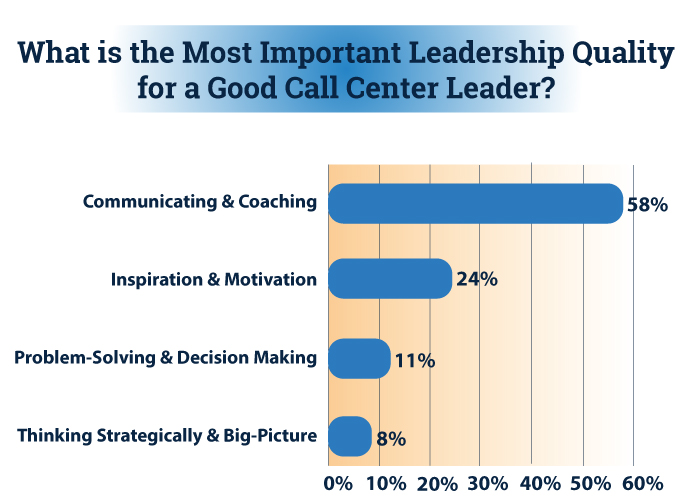
4. How to Know Your Leadership Style?
The information below describes the most common call center leadership styles. Please complete the online leadership style questionnaire to determine and compare your dominant style to other styles. In addition, it might be helpful to ask others what they think your dominant leadership is; it could be different than what you consider it to be.
- Servant Leader
- Participative Leader
- Transformational Leader
- Transactional Leader
- Autocratic Leader
- Laissez-Faire Leader
These leadership styles are based on several well-known academic leadership researchers, such as Bass, B. M., Avolio, B. J., Riggio, E. R., Burns, M. J., Conger, J. A., Greenleaf, R. K., Blanchard, K., Northouse, P. G., and Rok, B.
1. Servant Leader
The servant leadership style is about serving agents who report to them. Put differently, servant leadership relies on the concept that leaders exist to serve agents instead of the other way around. As a result, servant leaders show empathy, are followers, value agents' input, and encourage collective decision-making.
You Might Be a Servant Leader If...
- It is your top priority to develop agents so they can provide great customer service.
- You're known for asking agents what you can do to help them provide high Csat.
- You place more emphasis on agent needs than yours.
2. Participative Leader
The participative leadership style (sometimes called democratic leadership) is when a leader asks for input from their agents and considers feedback from their team members before making a decision. The participative leadership style is one of the most prevalent styles used by our call center client managers.
You Might Be a Participant Leader If...
- You think the best agent coaching sessions were when it was a collaborative approach for determining how they could improve their Csat.
- You think the best team meetings are when all agents have an equal opportunity to provide input.
- You can't remember the last time for an important decision that you did not seek input from agents.
3. Transformational Leader
The transformational leadership style leader is recognized as a change agent with effective strategic and critical thinking ability. In addition, they have strong communication skills and can create and articulate a clear call center vision, mission, and CX goals. A transformational leader is a manager who motivates and inspires agents to achieve transformation goals.
You Might Be a Transformational Leader If...
- You are a strategic or big-picture thinker who can come up with a new idea and have the ability to communicate it effectively.
- You encourage agents to be comfortable with being uncomfortable with change to make things better or improve Csat.
- You love to inspire and recognize agents who have significantly helped achieve transformational goals.
4. Transactional Leader
The transactional leadership style is where a leader relies on rewards and punishments to achieve optimal agent performance. These leaders focus on results, efficiency, and performance rather than agent relationships. They also tend to be directive and action orientated. The leader establishes goals, and agents know how they will be rewarded for achievement.
You Might Be a Transactional Leader If...
- You frequently use the threat of mandating overtime if agents do not adhere to the schedule.
- You motivate agents with money to improve their productivity or Csat.
- You punish agents with job loss or written notice of performance issues when productivity is low.
5. Autocratic Leader
The autocratic leadership style (also known as authoritarian leaders) directs and controls most activities without much input from agents who report to them. The most effective autocratic leaders lead with a clear sense of purpose and direction. This style can be the right leadership style when there are time constraints to complete tasks or if agents require high supervision.
You Might Be an Autocratic Leader If...
- You think agent input only slows things down, and it is more effective if you make decisions yourself.
- You believe because there is so much agent turnover, you need to be directive to agents on how you want them to resolve calls and provide Csat.
- You dislike it when agents question your knowledge or decisions, especially new agents.
6. Laissez-Faire Leader
The laissez-faire leadership style represents the absence of leadership. As the french phrase implies, a laissez-faire leader takes a hands-off approach to managing agents. For example, this leadership style is often unaware of what the agents who report to them on what they are doing. Furthermore, this leadership style believes its agents are trained and self-motivated to be high performers.
You Might Be a Laissez-Faire Leader If...
- You believe you take a hands-off approach in the way you manage agents day to day activities.
- You only step in when there are low Csat or performance issues.
- You do very little talking in the agent team meeting. Instead, the agents provide you with updates on their performance.
5. How to Develop Leadership Skills and Be a Good Leader?
Learning to be a good leader will likely positively impact call center agents and yourself. To be a good leader, you need to understand your leadership style and your leadership quality, strengths, and weaknesses. It can be very helpful to ask your subordinates, peers, and supervisor what they think are your leadership quality strengths and weaknesses. Furthermore, good leaders recognize that there is always room to improve their leadership qualities.
Good leaders can connect emotionally with their agents by having strong communication skills, encouraging personal growth and development, and using a two-way feedback approach. Some good leaders are introverts, and others are extroverted. Many leadership experts believe that a specific personality is not required to be a good leader. However, many leadership qualities have been identified as strong indicators of good leadership in a call center environment. The top call center leadership qualities that successful Csat leaders have in common include:
- Communicating & Coaching
- Inspiration & Motivation
- Problem-Solving & Decision-Making
- Think Strategically & the Big-Picture
A. Communicating & Coaching
The foundation of good leadership is strong communication and coaching skills. It is highly unlikely that you will be skilled in the other essential leadership qualities identified in this blog if you don't have effective communication skills. To improve your communication skills, you will want to explain everything from call center goals to call handling standards in concise language. If every agent on your team or department is unaware of your expectations and falls short of meeting them, you could be at fault for not effectively communicating them.
It is also helpful to identify your strengths and weaknesses in using the phone, chat, video conference, email, and face-to-face communication channels and work to improve where necessary. Good leaders can adapt their agent communication mode to each situation and agent preference. For example, depending on the situation and agent, it might be that text, email, chat, video conference, or face-to-face communication channel is the right approach for the situation and agent to ensure effective communication.
To be an effective communicator, you need to be a good listener. To improve your listening skills, you'll want to practice your active listening skills (e.g., carefully paying attention to what the agent is saying). Active listening builds trust, respect, and long-term relationships. Good leaders don't interrupt, show empathy and acknowledge what the agent has said by restating key points. Furthermore, call centers need leaders who listen to their agents. Improving active listening skills can be difficult; leaders must be self-aware about communication interactions and respect the direct report's viewpoints.
Supervisors should train agents to match their communication style to a customer's Persona Communication Style to create a stronger connection and enhance their experience in doing business with your organization, resulting in higher call resolution and Csat ratings. Each persona impacts the preferred way a customer and an agent acts, thinks, and makes decisions. By identifying the Persona Communication Style, an agent can use behaviors and word choices that match the customer's Persona Communication Style.
Coaching agents is arguably the most critical responsibility for call center leaders. Effective agent coaching is known to foster engagement and achieve high Csat. Most call center leaders who coach agents come up through the ranks with no or limited background or training in specific coaching techniques. However, in many cases, successful coaches are passionate about learning and developing agents to be successful at delivering high Csat.
It is vital to allow agents to evaluate their own call. This ensures agent engagement in the assessment of the call. In addition, the agent is often harder on themselves than their call center leader coach. As a result, coaching becomes more collaborative when looking for ways to improve Csat. For example, you should avoid telling agents what they need to do to improve their Csat, if possible. Put differently, teach agents instead of giving orders. In most cases, coaching must be collaborative to develop a mutually agreed upon improvement solution.
It is common for leaders to devote most of their coaching time and efforts to struggling agents, and/or their Csat performance is below the rest of the team. Keep in mind, though, that your average or high-performing Csat agents are, in most cases, the ones who are more likely to help improve your team's overall Csat performance. Therefore, the opportunity to improve their skills and expertise is more likely to have a higher ROI for your coaching efforts than spending most of your time with your lower Csat performing agents.
One of the biggest complaints we hear from agents is the lack of coaching time and cancellations of coaching sessions. Even though coaching is viewed as a supervisor's most crucial job responsibility, coaching often gets placed on the back burner when there is a higher call volume than expected. A leader needs to walk the talk when it comes to being committed to agent coaching. Therefore, leaders must block out time on their calendars to ensure agent coaching sessions occur.
One of the essential aspects of agent coaching is setting a mutually agreed upon goal. Moreover, it's important to recognize an agent's progress toward a specific goal. For example, if the agent's goal for Csat score is 85% and is currently performing at 70%, you need to recognize progress along the way (e.g., 75%, 80%, and 85%) to motivate the agent to achieve the Csat score goal of 85%. Recognition should be done at the agent coaching session and team meetings. In addition, leaders should recognize at least three or more agents daily for making progress towards their Csat goals.
SQM agrees with most call center professionals' opinion that coaching agents is critical. However, there is an opportunity to be more effective at agent coaching to improve FCR, call resolution, and Csat. Given the excellent opportunity to improve agent call resolution and Csat, all supervisors should be trained on a voice of the customer (VoC) agent coaching model. This approach uses post-call surveys and call compliance metrics to assess call quality for coaching agents. Figure 1 shows an ongoing four-step VoC Agent Coaching model (i.e., 1. Call Assessment, 2. Develop Action Plan, 3. Agent Communication, and 4. Agent Feedback) for helping Agents improve call resolution and customer service performance.
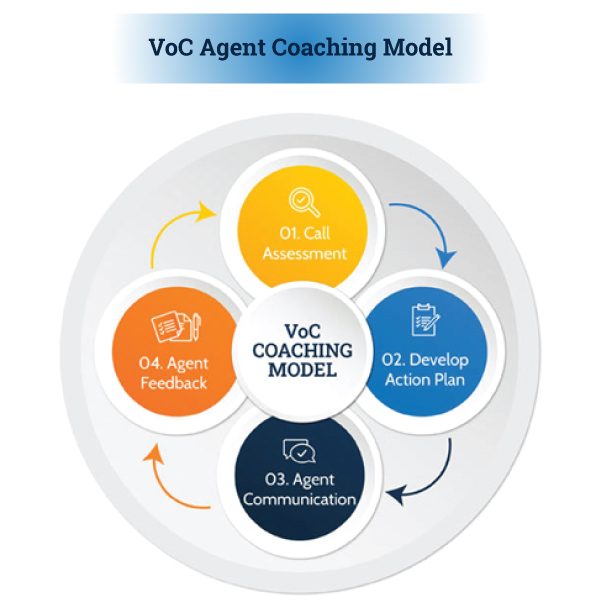
B. Inspiration & Motivation
Agent engagement remains low in the call center industry. SQM research show that only 27% of agents say they are highly engaged. Perhaps this is one of the main reasons annual agent turnover in 2022 is over 35% and is the highest turnover percentage we have ever measured in over 25 years of benchmarking this metric. High agent turnover is one of the main reasons why call centers have low Csat. Inspiring and motivating agents are great techniques for increasing agent engagement and achieving high Csat.
Successful call center leaders always seek ways to inspire and motivate agents and know they can't use a one-size-fits-all approach. When it comes to generation X (born 1965-1980), millennials (born 1981-1996), and Generation Z (born 1997-2012), leaders may need to reevaluate how to inspire these very different generations. It is essential to understand what inspires and motivates these distinct generations.
Good leaders have a Csat goal and the ability to inspire how agents can help achieve it and get them excited about it. This means that the leader maintains a positive yet realistic presence within the call center, assisting agents in staying motivated and engaged and remembering what they are working to achieve. As a call center leader, it can be challenging to be chipper all the time. However, a leader must pass a sense of optimism to their agents as much as possible. Agents like working for a positive manager. Furthermore, it isn't easy to inspire or motivate agents if a leader is not positive.
A great way to inspire and motivate agents in a call center environment is to show recognition for agent achievements. A best practice is to recognize agent behavior and reward the voice of the customer (VoC) results in a frequent, descriptive, and impactful manner. Agents need to know what they are being recognized for because it motivates them to continue to use the behaviors that helped them achieve CX metrics such as FCR, call resolution, and Csat results.
Interestingly, the number one reason agents quit their call center job is due to lack of recognition. In the call center, agent needs can be met by customers, peers, and management, showing appreciation and recognition for the customer service provided. Agent recognition should be carried out by their supervisor, the peers they work with, and the customers they serve.
Maslow's hierarchy of needs can best describe the psychology of recognition. Josh Bersin (2012) noted that "two of the most valuable psychological needs we have as human beings are the need to be 'appreciated' and the need to 'belong.'" As Bersin stated, and SQM agrees, "compensation and benefits support basic extrinsic human needs; however, recognition, training, appreciated and career advancement support our higher-level psychological intrinsic needs."
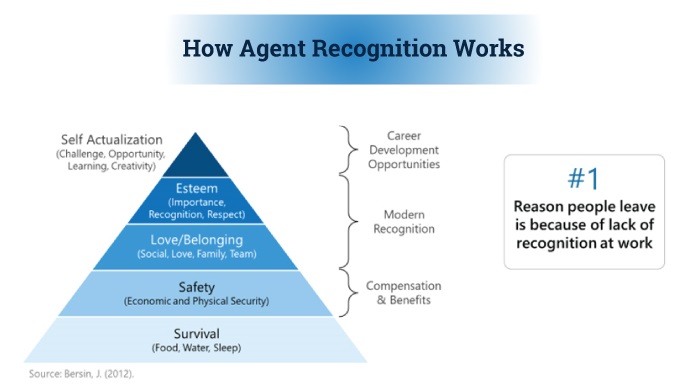
Motivating agents to use the desired customer service behaviors to achieve high Csat and call resolution performance and engage agents are great challenges. Furthermore, 46% of customers whose call was not resolved felt the agent could have done more to resolve their call. In many cases, the agents were not motivated to use the desired customer service behaviors to resolve customer calls. In other words, from a customer's point of view, it was a will issue rather than a skill issue.
As mentioned, recognition needs to be provided in a frequent, descriptive, impactful, and personal manner so that agents know why they are being recognized. In turn, agents are motivated to continue using the behaviors that helped them achieve high VoC results.
Be Frequent – by recognizing agents daily, weekly, monthly, quarterly, and annually -the more timely, consistent, and frequent, the better.
Be Descriptive – by recognizing agents for specific behaviors that they used to resolve a call or provide great CX. The more descriptive the feedback is, the more the agent will feel it is sincere.
Be Impactful – by focusing agent recognition on behaviors that positively impact FCR, Csat, and call resolution performance. These are the behaviors you want the agent to repeat.
Be Personal – by knowing that each agent is motivated by recognition differently. For example, do they prefer private or public recognition? Are they motivated by career opportunities, money, and time off, or do they feel appreciated and valued by leadership?
C. Problem Solving & Decision Making
Problem-solving for customer issues at the call center supervisor and agent levels has been an Achilles heel for the industry for a long time. Furthermore, SQM has found that most call centers struggle with improving Csat. Unfortunately, only 2% of call centers can sustain 3 years of continuous improvement for increasing the Csat and FCR rate annually. A significant reason for the Csat and FCR continuous improvement issue is that most call center leaders and agents are not skilled in problem-solving techniques for improving Csat.
Having call center leaders and agents skilled in problem-solving and decision-making techniques for fixing customer journey issues can significantly help improve Csat. Therefore, systematically fixing customer journey issues facilitates problem-solving and decision-making. Below is a 12-step process that can help call center leaders and agents fix even the most complex customer journey issues:
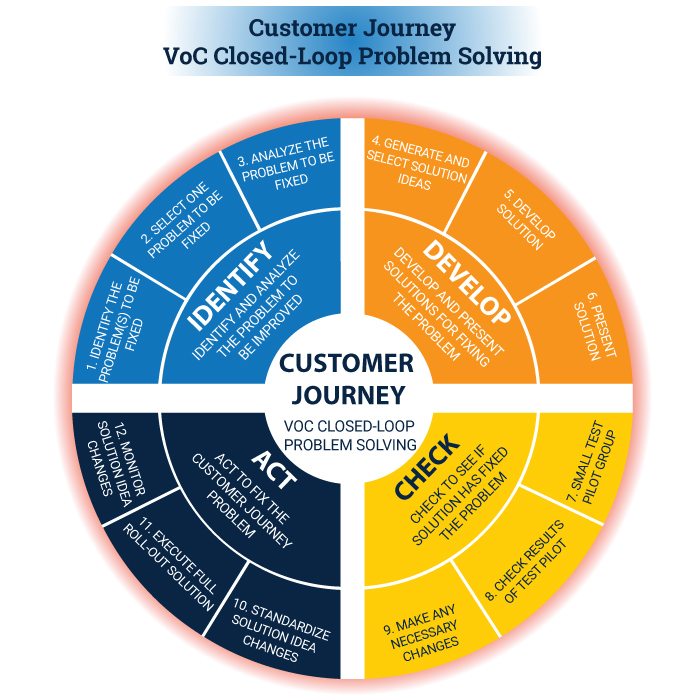
1. Identify the Problem(s) to Be Fixed
Many supervisors and agents struggle with identifying a problem. Of course, not every call is a problem. However, approximately 30% to 50% of the calls could be categorized as a problem for the average call center. In addition, SQM research shows that 14% of customers would define their call as a customer complaint, and for practical reasons, any complaint should be viewed as a problem that needs to be fixed. Furthermore, for customers who call more than once due to the initial call being unresolved, it is likely this repeated call could be identified as a problem that needs to be fixed. The challenge for many supervisors and agents is deciding if the customer's call reason is an inquiry or a problem.
In the first step, to help identify if the customer's call reason is a problem that needs to be fixed, ask the customer or yourself the following questions:
- What is the customer's call reason?
- Was the call reason an inquiry or problem?
- Was the customer upset about the problem?
- Why did the customer have to call back to resolve their initial call reason?
- What would the customer like you to do to fix the problem?
- Are other customers experiencing the same problem?
- Is the problem being caused by known issues?
- Is the problem source of error a customer, agent, or a company issue?
- What was the problem tag (e.g., needed to verify status, misinformation)?
These questions can help the supervisor or agent identify if there is a problem that needs to be fixed and potentially the root causes. Furthermore, identifying the problem enables a supervisor or agent to provide service recovery if necessary.
For call handling standards, agents need to confirm their understanding of the call reason or problem by restating what the customer said they are calling for and having the customer acknowledge they got it right. Furthermore, to ensure that agents know what the problem to be fixed is, they should use open-ended questions (e.g., 5 W's – what, why, who, where, when, and how) and closed-ended questions such as do, did, if, can, will and would.
2. Select One Problem to Be Fixed
In the second step, select only one problem to be fixed. If you focus on many problems simultaneously, it is less likely you will fix them all or any. However, if you are a supervisor and there are many customer calls that need to be fixed, your natural inclination is to do it by a first in first fixed approach. Although this might be the right approach in some cases, it might not be the most effective. For example, if a call center problem needs to be fixed (e.g., training or coaching issues), it would be more effective to train all agents or just fix the issue than to try to fix the problem one customer at a time.
Obviously, at the agent level, they identify a problem while they are on the phone or handling an email; therefore, they need to fix that problem while they are interacting with the customer. However, at the supervisor, line of business, or call center level, identify one problem to fix and analyze that hinders customer service. This is done using the customer survey external repeat call reasons tally report or problems identified in CRM, escalated calls, or QA technologies.
The second step is to select the top problem call reason to improve by using a selection grid (criteria = doable, cost, risk, mgmt support, and Csat gains) to determine what one problem should be fixed. SQM views utilizing the combination of post-call surveying, CRM, escalated calls, and QA data to determine what one problem to work on is the best approach.
It is important to emphasize that working on trying to fix too many problems at the same time can be very problematic and can sometimes result in nothing or very few problems getting fixed. Once you have fixed the problem, move on to the next problem based on using the selection grid.
3. Analyze the Problem
SQM Group's research shows that the average FCR rate is 70% for the call center industry, which means 30% of customers have to call back the call center to resolve their initial interaction. Furthermore, for every 1% improvement in FCR, there is a 1% improvement in customer satisfaction.
The third step is systematically identifying problems by understanding the root causes and the source of errors (SoE) to analyze the problem effectively.
When SQM examined the root causes based on customer feedback, we discovered the SoE for non-FCR calls, that the customer was the SoE 13% of the time, an agent was the SoE 38% of the time, and the organization was the highest SoE at 49% of the time. The organization's SoE issues result from policies, procedures, and technologies root causes that the call center has limited or no control for fixing.
Moreover, SQM research shows root causes for the top five repeat call reasons that hinder delivering great Csat and FCR are:
-
A customer needed to check or verify the status of their unresolved interaction
-
The customer got disconnected while being on hold
-
Agent lacked the knowledge to resolve the interaction (e.g., claims, technical)
-
The fulfillment department did not complete the customer request
-
The customer had to be redirected to another company
Achieving high or improving FCR requires call center leadership to be highly committed to enhancing the support experience for agents, customers, and the organization. Furthermore, it is critical to determine the root causes for SoEs and the repeat call reasons for non-FCR calls. The bottom line is systematically identifying problems by understanding the root causes, and the SoE is a best practice.
4. Generate and Select Solution Ideas
The fourth step is to generate and select solution ideas at the management or support group level. Brainstorm solution ideas with the customer or team and use a selection grid (criteria = doable, Csat gains, cost, mgmt support, and customers at risk) to determine what solution should be used and present ideas to a customer or call center management team.
At the agent or super level, to brainstorm possible solutions, ask yourself the following questions:
-
Can the escalation or helpdesk agent help you solve the problem?
-
Can someone from a different function (e.g., claims. IT, billing, sales) help you develop possible solutions?
-
Are there viable solutions in your knowledge management system?
-
What have other agents done to resolve this type of problem?
-
Does your supervisor or manager have a solution idea to resolve this type of problem?
-
Does the customer have a solution idea that works for them to fix their problem?
-
What are other call centers or competitors doing to fix a similar problem?
When going through the brainstorming process, it might be helpful to use a selection grid to decide what solution idea you want to present to the customer or management.
5. Develop a Solution Plan
In the fifth step, most solutions do not require a plan and are relatively straightforward to implement. But for more complex solutions, consider the following developing a solution plan elements:
-
What – is the solution to be executed?
-
Why – did you use the selection grid to determine if this is the best solution?
-
Who – is required to be involved in executing the solution?
-
Where – does the solution involve the customer, or is it done behind the scenes?
-
When – will the solution be implemented?
-
How – will the solution be implemented?
6. Present Solution
The sixth step is when the solution has been determined, and you are now ready to present a solution to the customer or management. Present the solution details and ask for feedback to ensure the customer or management agrees with your solution. Of course, you might have to alter the solution to meet the customer's or management's needs, so be prepared for potential changes that might be needed.
7. Small Test Pilot Group
In the seventh step most cases, a small test group will not be necessary when an agent comes up with the solution. The solution just needs to be executed. However, if the solution is more complicated, all stakeholders (e.g., customers, management) might need to align with the solution. Furthermore, it is helpful to use a small test pilot group (e.g., small scale) to determine the change impact to ensure the solution's effectiveness before rolling it out to the entire call center.
8. Check Results of Test Pilot
In the eighth step, an agent has implemented the solution, or results of the test pilot are available, check the agent execution or the test pilot's results. The success criteria for checking the results of the test pilot should be based on VoC performance (e.g., Csat, FCR, Cost). It is also helpful to gather qualitative customer feedback to see if the customer journey needs any improvement and, if it does, determine what needs to improve. This is the last step required if the solution is successful at the agent level.
9. Make Any Necessary Changes
The ninth step is to make any necessary changes to improve Csat performance. If the success criteria are achieved, proceed to full implementation. If Csat performance improvement criteria are not achieved, review implementation execution and go back to the fourth step.
10. Standardize Solution Ideas
The tenth step is standardizing solution ideas for operating procedure (SOP) changes. This is done by developing a 'solution idea operating procedure changes' manual. A well-documented manual is critical to implementing the solution ideas properly.
It has been SQM's experience that most call centers have used SOP practices to varying degrees for a long time. However, call centers performing at high FCR and Customer Satisfaction levels tend to be effective at SOP call handling practices for all their core call types and lines of business. In addition, SQM has many clients who have improved their FCR and Csat performance by enhancing their existing SOP practices.
11. Execute Full Roll-out Solution
The eleventh step is implementing the solution ideas for the entire call center. It is important to emphasize that a great solution idea is only as great as the solution execution. If a change management team is available, engaging them in executing complex and important solution ideas can be beneficial.
12. Monitor Solution Idea Changes
The twelfth step is to monitor solution idea changes. Again, this is done using VoC Csat, FCR, and customer feedback criteria to determine if the solution ideas have been properly implemented. Once the solution ideas have been fully implemented, continue to look for incremental improvements to refine the solution.
D. Think Strategically & the Big-Picture
What is Thinking Strategically?
Customer service strategically thinking involves seeing the big-picture, planning for the future, and allocating resources to implement their plan to gain a competitive advantage in your call center's Csat. Unfortunately, most people think that strategic thinking is only for senior managers. However, it must happen at every management level in the call center. So ask yourself this question: do you think about the big-picture, or do you need to be more strategic? Unfortunately, SQM research shows that most call center leaders think strategic thinking and the big picture are not as crucial as other leadership qualities. Therefore, most call center leaders have less emphasis on enhancing their strategic thinking skills when compared to other leadership quality skills.
Why is Strategic Thinking Important?
SQM believes that call center leaders need to focus more on enhancing their strategic thinking skills. The competitive environment can change quickly for any company or call center. New trends in people, processes, and technology may emerge quickly and require your call center to take advantage of them or fall behind in your Csat performance. By incorporating strategic thinking into your daily call center work, you will become more skilled at understanding the big-picture, problem solving, decision making, and developing action plans to improve Csat performance. Thinking strategically can help you make a greater contribution to your role and become essential to your company. Why? Because leaders that are capable of thinking strategically and the bigger picture can have a tremendous impact on the call center's Csat trajectory.
5 Key Qualities of Strategic Thinkers
Here are five qualities that most strategic thinkers have and continue to improve through their business working life.
-
Strategic Foresight Skills: Strategic thinkers have the capability of thinking of future and potential problems. They know how to develop customer service strategies that differentiate them from their competition and have backup strategies that can help them pivot quickly to a different customer service strategy if required.
-
Communication Skills: Developing a customer service strategy for your call center or team requires good communication skills. The ability to communicate complex solutions, and ideas, collaborate with external and internal stakeholders, and ensure that all agents are aligned to achieving Csat goals are all central to strategic thinking.
-
Analytical Skills: To develop a customer service strategy that helps your call center achieve its goals, you need to be capable of analyzing internal data (e.g., AHT, cost per call, agent utilization) and external data (e.g., Csat, FCR), emerging technical trends, and internal resource allocation. The ability to analyze this data is crucial to developing a strategy that has helped solve the problems and challenges of the call center.
-
Industry Knowledge Skills: To be a strategic thinker, you need a good understanding of the call center industry, people, processes, technology trends, and business drivers for improving customer service. It's helpful to analyze and interpret trends in your day-day work. Furthermore, you need to discuss with your subordinates, peers, and manager to understand their observations of the call center trends, then share those findings.
-
Problem Solving Skills: Strategic thinkers excel at problem-solving and decision-making. It is common for strategic planning to be used to assist in solving problems or addressing challenges such as agent engagement or Csat. Implementing a strategy that addresses the problems or challenges you face requires you first to understand the problem or challenge and potential solution ideas. From there, you are ready to develop a strategy that solves it.
5 Steps to Help Improve Your Strategic Thinking Skills
-
Make the time to reflect and plan for the future, analyze trends, prioritize tasks and decide on resource allocation required to achieve strategic goals.
-
Seek out call center subject matter experts and leaders within your company and outside your company to obtain quality insights that you can use in your strategic thinking.
-
Be open-minded and objective to be able to think clearly about a customer strategy to achieve your Csat goals.
-
Learn to be good at asking the right questions to credible sources to discover solution ideas that can make a positive impact on helping deliver customer service that differentiates your call center from your competitors.
-
Be willing to explore all alternatives and consequences of using different strategies and directions to deliver customer service. Test using post-call surveying to validate Csat impact.
Quick Related Links
First Call Resolution Comprehensive Guide Customer Satisfaction Comprehensive Guide Why Great Customer Service Matters Good to Great Customer Service Leadership Style for Call Centers Handling Customer Complaints

